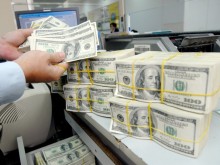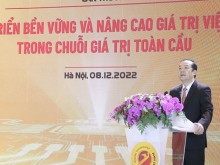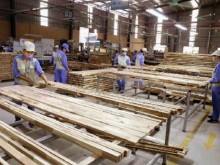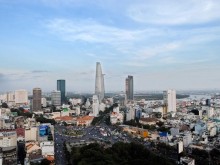Vietnam and the Netherlands have seen ample opportunities to bolster their decades-long relations. Given mutual interests and shared visions, cooperation in sustainable development is gaining traction with the determination of the two countries over the years.
Shared concerns
Since their establishment in 1973, Vietnam-Netherlands relations have grown steadily in areas such as trade, investment and climate change mitigation. As of March, data by the Vietnam News Agency showed that the Netherlands had become the biggest European Union investor in Vietnam, with a total of US$13.89 billion pledged. Vietnam’s trade surplus with the Netherlands was the second highest in 2022.
During the height of the Covid-19 pandemic, Vietnam received one million doses of vaccines and other medical equipment totaling VND43 billion equivalent from the Netherlands. In addition, collaboration on sustainable growth has long been a priority in bilateral ties, as climate change poses severe challenges for both Vietnam and the Netherlands.
“Half of the Netherlands is under sea level,” Consul General of the Netherlands in HCMC Daniel Stork told The Saigon Times late last week, adding that if climate change continues the way it is now, the country would disappear on the level of the sea.
According to Stork, the two nations have seen opportunities to support each other, given that the Mekong Delta region has also been threatened adversely. “We face serious risks, as does Vietnam,” he added.
With a coastline of 3,200 kilometers and low-lying areas, Vietnam is highly prone to climate change, according to a report released in July 2022 by the World Bank (WB). The country faces an annual loss of 12-14.5% in GDP by 2050 due to the severe consequences of climate change, cited the WB report.
Similarly, the Netherlands has seen negative effects due to climate change, including increased flooding risks and declined surface water quality and biodiversity, as stated by the PBL Netherlands Environmental Assessment Agency, a national environment and spatial planning institute.
In 2010, Vietnam and the Netherlands established a Strategic Partnership on climate change adaptation and water management.
In 2014, the two countries set up a Strategic Partnership on sustainable development and food security. Vietnam and the Netherlands have scaled commitments and taken tangible actions to foster long-term development in the face of common challenges.
Mutual interests
In 2013, Vietnam and the Netherlands launched the Mekong Delta Plan, an initiative promoting regional sustainable development as part of the 2010 strategic partnership on climate change adaptation and water management. In 2022, the Netherlands continued to support Vietnam in achieving the Mekong Delta Regional Master Plan objectives, particularly in terms of sustainable value chains, nature-based solutions and agro-business hubs.
“We have many large businesses, many general managers working in the field of agriculture, and they are helping in the agro-transformation to more sustainable agriculture in Vietnam,” said Stork.
The efforts involve using clean energy in factories, having proper wastewater treatment, recycling and working sustainably. “The biggest opportunity is in water management and sustainable agriculture,” he added.
In recent years, Vietnam reportedly received some US$10 million from the Netherlands for water supply and sanitation programs.
Last December, Vietnamese Prime Minister Pham Minh Chinh and Dutch Prime Minister Mark Rutte agreed to deepen the two countries’ strategic partnership during a meeting at The Hague. Given the unwavering commitment to sustainable development, the frameworks have significantly contributed to shaping the current upbeat trajectory of Vietnam-Netherlands relations, in addition to trade and investment.
For both countries, international cooperation remains a top priority in coping with climate change. Prime Minister Chinh said climate change had been “the greatest challenge to mankind” at the 26th United Nations Climate Change Conference of the Parties in 2021, or COP26. He called for joint efforts in bolstering international cooperation through investment programs and sustainable development projects.
The vision was shared by the Netherlands. The Dutch Government stated that international cooperation is the best way to deal with greenhouse gas emissions and global warming.
Vietnam and the Netherlands have been part of many multilateral agreements in response to climate change, including the 2015 Paris Climate Accords. At COP26, PM Chinh announced Vietnam’s commitment to net-zero emissions by 2050. The objective is in line with the Netherlands’ goal of reducing net carbon emissions to zero, as stated in the Climate Act objectives.
Cooperation focused on provincial level
In HCMC, there have been effective dialogues between the city administration and its Dutch counterparts, particularly in Rotterdam City, according to Consul General Daniel Stork. He said the city’s mayor, Ahmed Aboutaleb, who was in HCMC last July, will return in June with a delegation to discuss flooding issues, climate change adaptation and port cooperation.
“It is a combination of things you need to think about to prevent climate change and also build a system of waterways and dikes and sometimes giving space back to nature so that the rivers do not overflow in downtown HCMC,” he said.
The endeavor was one of the plans proposed during PM Chinh’s visit to the Netherlands last year. The two countries talked about prospects for leveraging “locality-to-locality cooperation,” including Hanoi-Amsterdam and HCMC-Rotterdam ties.
The Dutch Consulate General recently held a bike tour around the city’s tourist attractions in District 1, such as the Opera House, Ben Thanh Market and Central Post Office. The event aimed to highlight Vietnamese-Dutch cooperation in green development and sustainable mobility. The cycling event was part of the activities held to mark the 50th anniversary of the establishment of diplomatic relations between the two nations.
According to Stork, cycling is one of the viable ways to deal with HCMC’s environmental issues. He said cycling helps the city minimize air pollution and traffic congestion.
“There is, of course, e-mobility with electric bikes and scooters. But the bicycle is the easiest way. And it is such a cheap way for people. It is accessible to anybody at any level of society,” added Stork. “It is quite easy to adapt the city’s infrastructure to bicycles.”
According to Stork, it took a long time for the Netherlands to become a cycling nation. “When opportunities came, you had discussions, and you showed that there are people who really want to cycle through the cities, to have sustainable mobility, to have less congestion, less cars and less danger.” The Netherlands now has around 25,000 kilometers of bicycle roads and 20 million bicycles, he added.

“This is a highlight for us here in HCMC, especially as far as our public events are concerned. Everybody has worked together to make this one of the highlights of the 50 years,” said Stork.
On the 50th anniversary of Vietnam-Netherlands diplomatic relations, Dutch PM Mark Rutte praised the solid partnership between the two countries, highlighting room for improvement in the face of global challenges.
“It is an opportunity for us not only to reflect on the past but also to look ahead to the future,” PM Rutte wrote in a letter sent to his Vietnamese counterpart.
Faced with mounting concerns about climate change, cooperation in sustainable development in Vietnam-Netherlands relations would be put to the test. There remain prospects for further growing bilateral ties. And more importantly, as Stork put it, “There is a lot to do together.”















